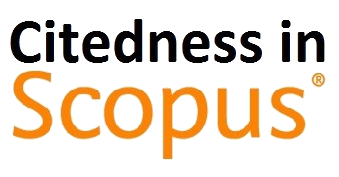Tourism Destinations Popularity Rating In Malang Raya using Naive Bayes Classifier and Selection Sort Based on Twitter Word Polarity
(1) Department of Informatics, Faculty of Science and Technology, Universitas Islam Negeri (UIN) Maulana Malik Ibrahim, Malang, Indonesia
(2) Department of Informatics, Faculty of Science and Technology, Universitas Islam Negeri (UIN) Maulana Malik Ibrahim, Malang, Indonesia
(3) Department of Informatics, Faculty of Science and Technology, Universitas Islam Negeri (UIN) Maulana Malik Ibrahim, Malang, Indonesia
(4) Department of Informatics, Faculty of Science and Technology, Universitas Islam Negeri (UIN) Maulana Malik Ibrahim, Malang, Indonesia
(*) Corresponding Author
Abstract
The development of tourism today has been supported by advances in information technology that can make it easier for everyone to get information about tourist attractions. Technology plays an essential role in improving the tourism industry sector. During the tour, tourists usually share moments by uploading photos or making a status on social media related to their experience visiting a tourist site. Malang, which has various types of tourism, makes it a tourist destination. However, the number of tours in Malang makes tourists confused to choose the trip to be visited. Because of this, we need a system that can provide information in the form of popular tourist rankings. In this research, a system that can determine the ranking of tourist attractions in Malang Raya was made. The data used comes from social media user tweets on Twitter using the keyword name of tourist attractions in Malang. The Naive Bayes Classifier method is used to help tweet classification, and the Selection Sort method is used to help the ranking process of tourist attractions. The final results obtained in the Batu City tourism ranking resulted in an accuracy of 86.3%, while in the tourism rating the artificial type of Batu City produced an accuracy of 100%. The difference in accuracy occurs because there are the same positive values at several tourist attractions, so the Selection Sort method cannot work. Because of this, further research is needed for ranking methods that can rank with the same positive value to produce a better ranking of tourist attractions.
Full Text:
PDFReferences
S. Bahri, “Analisis Faktor-Faktor Yang Mempengaruhi Korupsi Dan Modus Korupsi APBD Di Malang Raya,” J. Manaj. Akunt. dan Bisnis, vol. 6, no. 1, p. 110805, 2008.
M. Vadivukarassi, N. Puviarasan, and P. Aruna, “Sentimental Analysis of Tweets Using Naive Bayes Algorithm,” World Appl. Sci. J., vol. 35, no. 1, pp. 54–59, 2017.
P. Dellia and A. Tjahyanto, “Tax Complaints Classification on Twitter Using Text Mining,” IPTEK J. Sci., vol. 2, no. 1, p. 11, 2017.
S. Fanissa, M. A. Fauzi, and S. Adinugroho, “Analisis Sentimen Pariwisata di Kota Malang Menggunakan Metode Naive Bayes dan Seleksi Fitur Query Expansion Ranking | Jurnal Pengembangan Teknologi Informasi dan Ilmu Komputer,” J. Pengemb. Teknol. Inf. dan Ilmu Komput., vol. 2, no. 8, pp. 2766–2770, 2018.
M. Murnawan, “Pemanfaatan Analisis Sentimen Untuk Pemeringkatan Popularitas Tujuan Wisata,” J. Penelit. Pos dan Inform., vol. 7, no. 2, p. 109, 2017.
D. T. Hermanto, M. Ziaurrahman, M. A. Bianto, and A. Setyanto, “Twitter Social Media Sentiment Analysis in Tourist Destinations Using Algorithms Naive Bayes Classifier,” J. Phys. Conf. Ser., vol. 1140, no. 1, 2018.
N. Yanti, R. Kurniawan, S. N. H. S. Abdullah, M. Z. A. Nazri, W. Hunafa, and M. Kharismayanda, “Tropical diseases web-based expert system using certainty factor,” Proc. - 2018 2nd Int. Conf. Electr. Eng. Informatics Towar. Most Effic. W. Mak. Deal. with Futur. Electr. Power Syst. Big Data Anal. ICon EEI 2018, no. October, pp. 62–66, 2018.
S. Mukherjee and P. K. Bala, “Sarcasm detection in microblogs using Naïve Bayes and fuzzy clustering,” Technol. Soc., vol. 48, pp. 19–27, 2017.
M. E. Al Rivan, “Perbandingan Kecepatan Gabungan Algoritma Quick Sort dan Merge Sort dengan Insertion Sort, Bubble Sort dan Selection Sort,” J. Tek. Inform. dan Sist. Inf., vol. 3, no. 2, 2017.
E. Retnoningsih, “Algoritma Pengurutan Data ( Sorting ) Dengan Metode Insertion Sort dan Selection Sort,” vol. 3, no. 1, pp. 95–106, 2018.
DOI: https://doi.org/10.30645/ijistech.v3i2.58
Refbacks
- There are currently no refbacks.
Jumlah Kunjungan:
Published Papers Indexed/Abstracted By:












